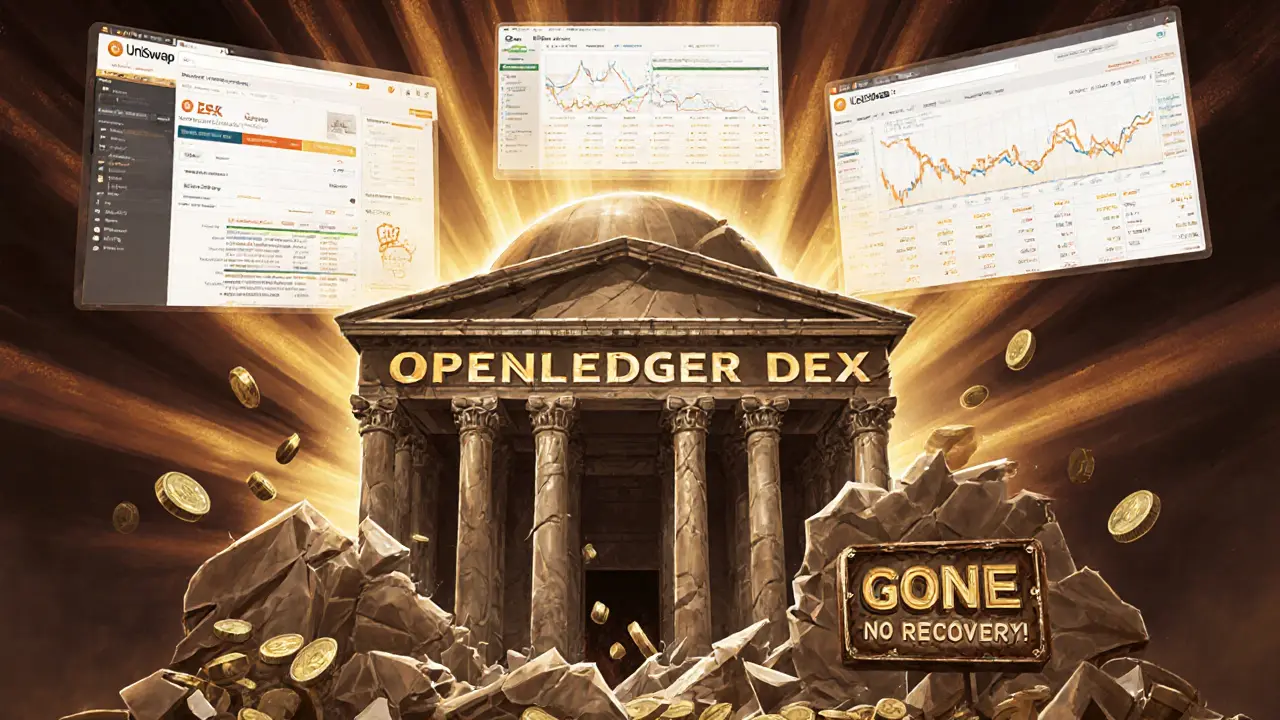Withdrawal Fee Calculator
How Much Would You Lose?
OpenLedger DEX charged a 5% withdrawal fee. Compare this to standard flat fees.
OpenLedger DEX was never meant to be another Binance or Kraken. It promised something different: a decentralized exchange built on the BitShares blockchain, claiming to handle over 100,000 trades per second. That’s faster than Bitcoin and Ethereum combined. But speed doesn’t matter if you can’t get your money out.
What OpenLedger DEX Actually Was
OpenLedger DEX launched as a decentralized crypto trading platform using the BitShares blockchain. Unlike centralized exchanges where your coins are held by the company, OpenLedger let you trade directly from your wallet. That sounds great in theory-no need to trust a third party, no hacks of hot wallets. But the reality was messy.
The platform had two interfaces: one simple for beginners, another advanced for pros. That’s rare for a DEX back then. Most decentralized exchanges were clunky, full of technical jargon. OpenLedger tried to fix that. But even if the UI was clean, the economics were broken.
The Fee That Killed It
Every trade on OpenLedger cost 0.20%. That’s not bad. Binance charged 0.10%, Kraken was around 0.16%. OpenLedger was only slightly higher. Fine.
Then came the withdrawal fee: 5%.
Let that sink in. If you wanted to pull out 1 BTC, you paid 0.05 BTC in fees. At $5,000 per BTC in 2020, that was $250 just to move your money. If you withdrew 10 BTC? $5,000 in fees. For context, most exchanges charge a flat fee-$1, $5, maybe $10. Not a percentage that grows with your balance.
Cryptowisser called it “the - by far - highest percentage based withdrawal fee we have ever heard of.” That’s not an exaggeration. It’s the kind of fee that makes traders laugh, then leave. And they did.
No Liquidity, No Trading
Even if you ignored the withdrawal fee, you couldn’t trade much. OpenLedger had no liquidity. That means no buyers, no sellers. You might see Bitcoin listed, but no one was offering to buy it at a price you liked. Or worse-you’d place an order and it wouldn’t fill for days.
Revain’s user reviews listed “no liquidity” as the top complaint. Without liquidity, a DEX is just a fancy dashboard with empty order books. It doesn’t matter how fast the blockchain is if no one’s trading.
Compare that to Binance in 2020. It had over $1 billion in daily volume. OpenLedger? A fraction of that. Maybe $1 million. And most of it was from people testing the system-not serious traders.

Why BitShares Didn’t Save It
OpenLedger’s tech was built on BitShares, a blockchain designed for high-speed trading. BitShares could do 100,000 TPS. That’s real. Ethereum at the time? 15 TPS. Bitcoin? 7.
So why didn’t that help?
Because speed doesn’t attract users if the business model is flawed. BitShares had other DEXs too. Most failed. Why? The same reason: no liquidity. Traders go where the money is. And in 2019-2020, the money was on centralized exchanges. They had deep order books, fiat on-ramps, customer support, and-critically-no 5% withdrawal fees.
OpenLedger never solved the chicken-and-egg problem: no traders → no liquidity → no traders. And the 5% fee made it impossible to recover.
The Shutdown
On May 15, 2020, OpenLedger DEX shut down. No warning. No notice. Just a message on their site saying operations had ended.
By May 5, 2025, Forex Peace Army confirmed the company was “out of business.” The website was down. No customer support. No contact info. No way to recover funds.
Any crypto you had on OpenLedger at that time? Gone. Not locked. Not frozen. Gone.
There were no audits. No proof of reserves. No transparency. And now, five years later, there’s zero chance of recovery.

What About OpenLedger Tokens or White Label DEXs?
Some websites still list “OpenLedger (OPEN)” tokens or “OpenLedger White Label DEX.” These are not the same thing.
The original OpenLedger DEX exchange is dead. These other projects are unrelated. One is a token on another blockchain. The other is a company selling DEX software to other businesses. Neither has anything to do with the exchange that shut down in 2020.
If you see someone promoting “OpenLedger” as a current exchange? They’re either misinformed or lying.
What You Can Learn
OpenLedger DEX isn’t just a relic. It’s a warning.
First: Never trust a DEX with percentage-based withdrawal fees. They’re designed to eat your profits. A 5% fee isn’t a feature-it’s a trap.
Second: Liquidity matters more than speed. A slow exchange with deep order books is better than a lightning-fast one with empty books.
Third: Check if the exchange is still active. Don’t rely on old reviews. Look for recent activity. If the website is down, if there are no social media updates, if CoinGecko removed it-walk away.
Fourth: Don’t assume decentralization means safety. OpenLedger was decentralized, but that didn’t protect your funds. If the team disappears, your coins disappear with them.
Today, there are better DEXs: Uniswap, SushiSwap, dYdX, PancakeSwap. They charge flat fees. They have liquidity pools. They’re audited. They’re active.
OpenLedger DEX didn’t fail because it was too innovative. It failed because it was greedy and careless. And its users paid the price.
Final Verdict
OpenLedger DEX was a technically interesting project with a fatal flaw. Its 5% withdrawal fee made it unusable for anyone trading more than a few hundred dollars. Its lack of liquidity made trading pointless. And when it shut down, there was no recourse.
It’s not a crypto exchange you should consider. It’s not even an option. It’s a case study in how not to run a decentralized exchange.
If you’re looking for a DEX today, skip the ghosts. Go for ones that are alive, transparent, and don’t charge you half your profit just to withdraw.



